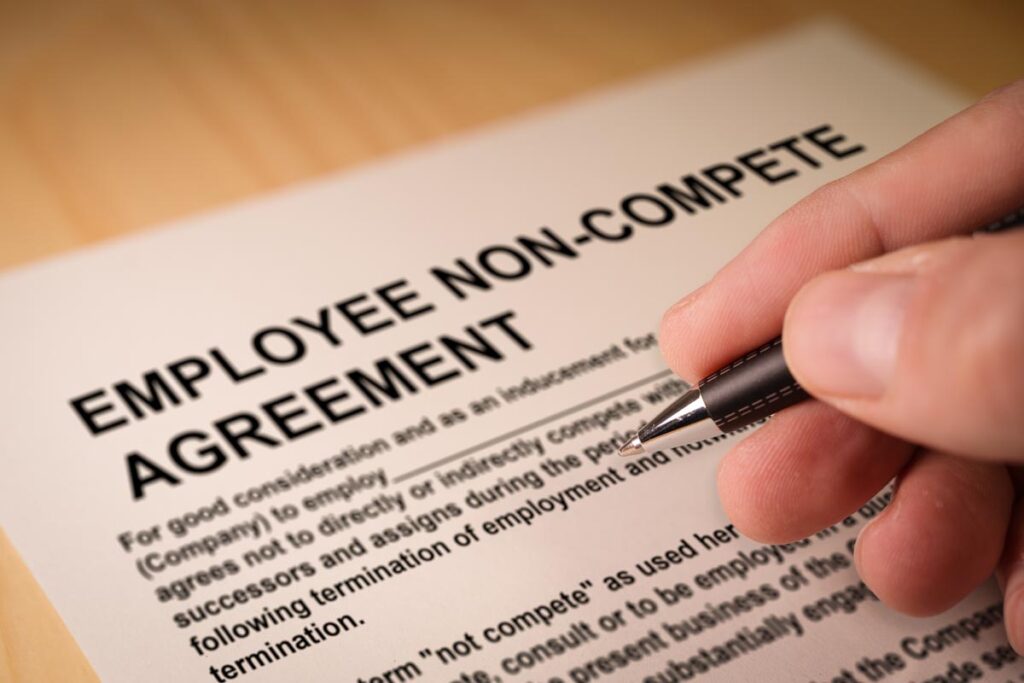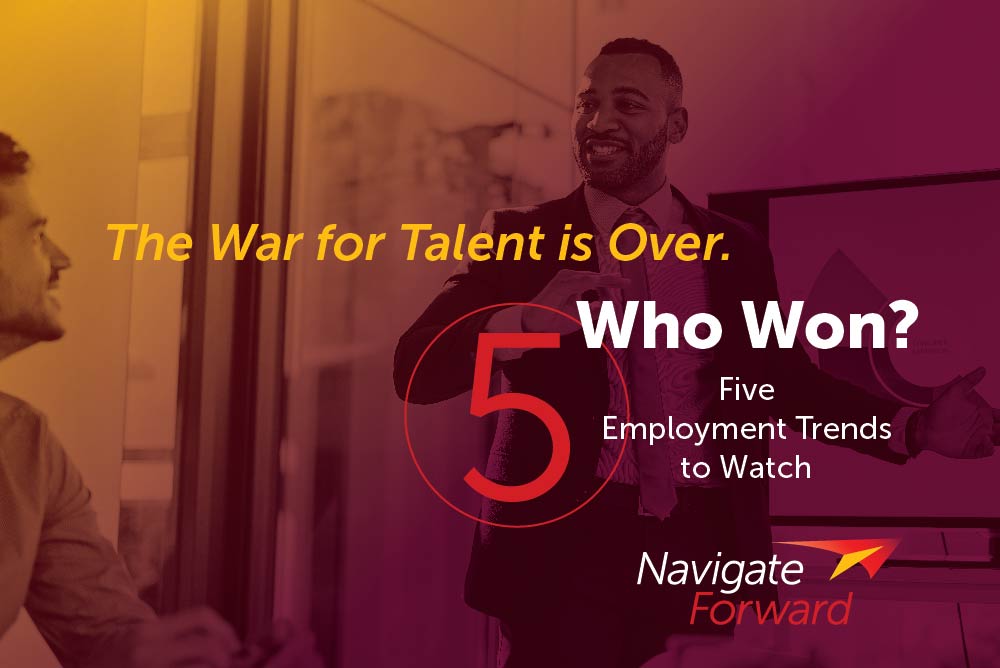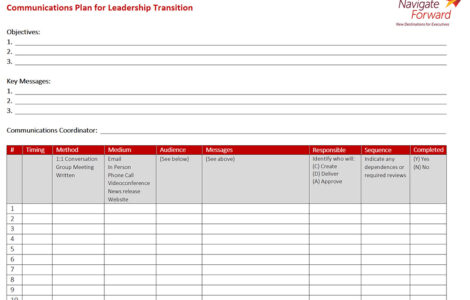If your HR department feels like a war zone these days, it might feel good to know you’re not alone.
In fact, at a recent CNBC Work Summit, PWC U.S. Chairman Tim Ryan told attendees: “The war for talent is over, and talent won.”
From the end of non-competes to the tug-of-war over return to office, there’s a reckoning underway between employers and employees. How your organization navigates this shifting balance of power will impact everything from corporate hiring and retention to employee satisfaction and productivity.
5 Employment Trends to Watch
Trend 1: Changing Non-Compete Policies Make Leaving Well More Essential Than Ever
 Earlier this year, the Federal Trade Commission proposed a new rule that would ban employers from imposing non-competition agreements on their workers. Nine states already have some form of non-compete ban, and Minnesota is the latest state to join their ranks, with a law that went into effect July 1, 2023.
Earlier this year, the Federal Trade Commission proposed a new rule that would ban employers from imposing non-competition agreements on their workers. Nine states already have some form of non-compete ban, and Minnesota is the latest state to join their ranks, with a law that went into effect July 1, 2023.
While you can’t prevent a departing leader from joining a competitor, you can treat their exit in a thoughtful and authentic way
As our Navigate Forward team has been researching and discussing the issue, we continue circling back to the idea that now more than ever, it’s critical that employees have the best possible experience when leaving a company.
While you can’t prevent a departing leader from joining a competitor, you can treat their exit in a thoughtful and authentic way. It’s the most proactive option to ensure they carry their loyalty and connection to your organization into their next chapter.
Trend 2: In a Shifting Balance of Power, Employees Want to be Treated Like Customers
 This has been a tiring, even chaotic, few years for HR leaders. As one senior VP recently told me, “It’s like we’re in a playground, and I never know which way the teeter totter is going.” Right now, it’s still employees who are at the top and calling the shots—at least as far as top-notch senior leadership candidates are concerned.
This has been a tiring, even chaotic, few years for HR leaders. As one senior VP recently told me, “It’s like we’re in a playground, and I never know which way the teeter totter is going.” Right now, it’s still employees who are at the top and calling the shots—at least as far as top-notch senior leadership candidates are concerned.
Part of the struggle is that even when we recognize how important it is to convey a strong employee value proposition (EVP) across all stages of the talent lifecycle, it’s easier said than done. It can be especially challenging during difficult transitions like RIFs. We’ve all read the horror stories about “layoff by Zoom” and other poorly handled company decisions.
This has been a tiring, even chaotic, few years for HR leaders
The bottom line? Employees subjected to callous treatment will share their experiences far and wide. Yet we believe that even during a difficult period, employees can be treated with respect, dignity and support. When that happens, they share those stories, too. Positive separations and experiences handled with care can make a big difference the next time companies need to ramp up hiring, retain key workers and keep morale and momentum high.
Trend 3: Your Employee Value Proposition Must Connect with All Generations
 Even with unemployment rates remaining at record lows, many corporations are struggling to attract a strong job candidate pool right now. If that’s the case at your organization, you might want to take a fresh look at your EVP. Not only is it important for current employees, but it’s a vital piece of information for prospective candidates who want to know more about you as they decide on which role best aligns with their own values.
Even with unemployment rates remaining at record lows, many corporations are struggling to attract a strong job candidate pool right now. If that’s the case at your organization, you might want to take a fresh look at your EVP. Not only is it important for current employees, but it’s a vital piece of information for prospective candidates who want to know more about you as they decide on which role best aligns with their own values.
Considering generational differences ensures your EVP resonates with everyone on the payroll
Taking generational differences into consideration is an important part of making sure your EVP resonates with everyone on the payroll; a one-size-fits-all message may well miss the mark.
For example:
- Baby Boomers, who are over age 59, put a premium on the terms and conditions of their work, with an emphasis on pay and benefits.
- Generation X, currently age 43 to 58, want to feel good about their jobs—and have a great relationship with their boss, too.
- Generation Z, whose oldest members are now 26 years old, note their highest priority is the corporate mission and a role with purpose and positive social impact.
Conveying your core values with messages that consider where an individual falls in their own career journey can make a big difference.
Trend 4: Gen Z Can Teach Us About Flexibility and Adaptability
 Along those same lines, we’re impressed by the youngest members of the workforce and believe they can teach us all a few things about resilience.
Along those same lines, we’re impressed by the youngest members of the workforce and believe they can teach us all a few things about resilience.
No generation in the last 75 years has confronted more chaos more quickly than Gen Z
The 70 million-strong Gen Z (born 1997-2012) has long been accustomed to turmoil in the workplace. As demographic expert John Della Volpe notes, no generation in the last 75 years has confronted more chaos more quickly. In their brief careers, Gen Z have experienced a pandemic, a switch to remote work, extended job hunts in tumultuous conditions, and likely one or more layoffs.
The takeaway? They know some highly relevant things about flexibility and adaptability in the face of what can seem like constant change.
By contrast, older workers haven’t faced the same chaos at the same pace; they likely need more support to navigate disruption. After so many years in one place, they can feel adrift when an unplanned transition or even a separation occurs. Having adequate resources available can ensure smooth outcomes for all.
Trend 5: A Leader’s Departure Will Impact Everyone in the Company
 Layoffs continue to make headlines, and the data data backs this up: Forbes reports that 194,000 jobs were cut in Q1 and Q2 of this year. Amazon, Google, Meta and Microsoft have led the pack, with layoffs totaling more than the previous two fiscal quarters combined.
Layoffs continue to make headlines, and the data data backs this up: Forbes reports that 194,000 jobs were cut in Q1 and Q2 of this year. Amazon, Google, Meta and Microsoft have led the pack, with layoffs totaling more than the previous two fiscal quarters combined.
If layoffs or executive departures are handled badly, that news spreads fast
As you know, if layoffs are handled badly, that news spreads fast. Employees might forget the copy machine code or the way to reserve the best conference room, but they’ll never forget the way a highly regarded leader or beloved mentor was treated on their way out the door.
However, if they leave on a productive and positive note, you’ll have made an important step forward in managing your reputation and preserving your culture.
We Help Executives Leave on a Positive and Productive Note
These days, having a positive reputation can be a deciding factor in your organization’s overall success. That’s why more companies understand how truly valuable the right outplacement services can be, both for outgoing staff and for your own employment brand. Future candidates and existing employees will notice that you’ve provided truly helpful services during layoffs, and authenticity like that can be a major factor when you’re hiring in the future.
Having a positive reputation can be a deciding factor in an organization’s success with recruitment and retention
At Navigate Forward, our passion is helping executives discover and realize the work that inspires them. We take a collaborative approach that supports every client until they land their new role, without any time limits.
- The senior leaders we work with (C-Suite, EVP, VP and Director positions) find meaning and guidance for their next role.
- Their former employers keep building a stellar reputation that makes a big difference when you’re competing for top talent in the future.
Our powerhouse team of career consultants average 30 years of experience as corporate leaders or executive recruiters, enabling them to deliver true peer-to-peer support. A low 1:12 client-to-consultant ratio means every executive receives personal attention. It’s a formula that results in successful next chapters for departing executives, and authentic support for companies experiencing separations that are challenging or high visibility.
Let us support your talent lifecycle. Our team are always just a phone call away and happy to help you navigate these (and other) changing circumstances. You can reach out to us by phone or email, and we’ll set up a meeting whenever it’s convenient. We also offer numerous helpful resources on our website.



